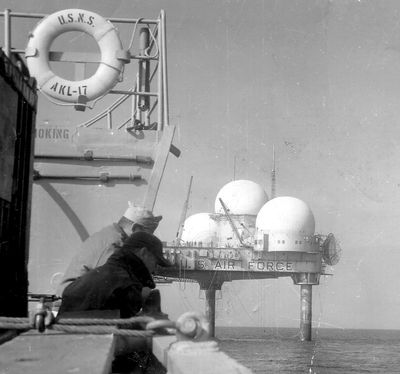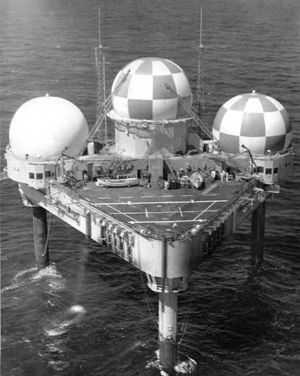Texas Tower 2
|
Texas Tower 2 (1958-1963) - A Cold War Air Force Radar Station first established in 1955 on Georges Bank off the coast of Massachusetts. One of three radar platforms built in the Atlantic ocean off the east coast of the United States. Initially assigned a Permanent ID of TT-2 and later a Sage ID of TT-2. Abandoned in 1963 and later sunk while being salvaged.
History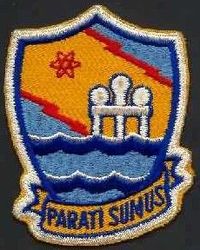 Established 2 Dec 1955 and became fully operational 17 April 1958 as Texas Tower 2 (TT-2) manned by elements of the 762nd AC&W Squadron and the 4604th Support Squadron. TT-2 became operational as a manual radar site with both a Ground-Control Intercept (GCI) and an early warning mission. The early warning mission involved tracking and identifying all aircraft entering their airspace while the GCI mission involved guiding Air Force interceptors to any identified enemy aircraft. Controllers at the station vectored fighter aircraft at the correct course and speed to intercept enemy aircraft using voice commands via ground-to-air radio. In September 1958 TT-2 became SAGE system operational feeding digitized radar data by Troposcatter communications to North Truro Air Force Station and from there by landline to the Stewart SAGE Direction Center DC-02. Communication difficulties sometimes forced a return to manual operation but by 1960 many of the difficulties had been overcome and automatic SAGE operation was the norm. The collapse and loss of Texas Tower 4 on 15 Jan 1961 with all hands on board was followed by a period of precautionary evacuations of TT-2 and TT-3. When major storms approached the towers were evacuated resulting in a significant number of lost operational days. As new ALRI airborne surveillance capability came online, the decision was made by the JCS in January 1963 to deactivate both of the remaining towers. Texas Tower 2 was decommissioned on 15 Jan 1963. Salvageable equipment was removed and a salvage company then dynamited the three legs hoping to float the upper structure to the shore. Instead of floating the structure sank and was not recoverable.
Texas Tower 2 Construction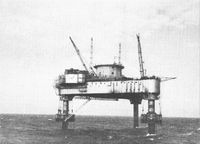 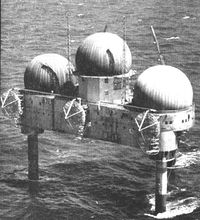 Texas Tower 2 was built in Quincey, Massachusetts, by the Bethlehem Steel company. The tower was built of steel with three decks in a triangular shape. Supporting the tower were three legs or casons that anchored it to the ocean floor. Tower two was floated out to Georges bank arriving about 15 Jul 1955 and the three 160' legs were lowered to Georges Bank and sunk into the bank about 48 feet. This left 55 feet underwater and 60 feet above the water. the tower was then jacked up 60 feet into the air and fixed in that position. The tower was built with three decks, the two lower decks housed the mechanical equipment and the crew quarters. Most of the top deck (weather deck) was devoted to a helicopter landing area and two large cranes. One side of the weather deck, enclosed in a 210' by 60' structure, was the operations area, radar, FST-2, and communications gear. Atop that structure were the three radar sets with antennas enclosed in protective bubbles. The Air Force assumed beneficial occupancy of the tower on 2 Dec 1955 and began the process of bringing the radar and communications gear on board. On 7 May 1957, the tower was declared operational on a limited basis. On 17 Apr 1958, it was declared fully operational in a manual mode and in September 1958 it became SAGE System operational. The cost of TT-2, including platform, legs, radars, and communications equipment was estimated to be $13 million. Yearly operating expenses were estimated to be $1.5 million.
Texas Tower 2 Equipment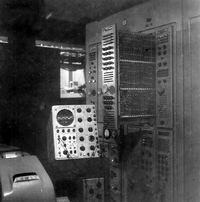 The largest piece of electronic equipment on the weather deck level was the duplexed FST-2 coordinate data transmitter, designed to transmit radar data in digital form to the SAGE direction center onshore. The initial radar equipment included the FPS-3A search radar and two FPS-6 height-finder radars. The three radar sets were by necessity very close to each other and to prevent them from interfering with one another the search radar was raised above the two height-finders and their physical movement was restricted to point away from the search radar. Communications with the shore were through a tropospheric radio system, FRC-56. The FPS-3A Radar was later upgraded to an FPS-20A and then to an FPS-67. The FST-2 was upgraded to an FST-2B with the addition of the solid-state SIFF cabinets.
Texas Tower 2 Operation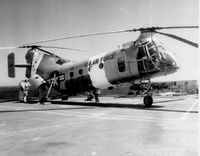 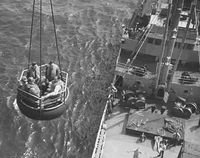 The logistics problems posed by the location of TT-2, 110 miles off the Cape Cod coast, were significant. Two methods were used to provision the tower and rotate personnel. The primary and the most reliable method was by the AKL-17 a small supply ship that made regular runs to the tower from New Bedford and Buzzards Bay. The ship could carry enough passengers to evacuate the tower completely in an emergency and was the only way to provide bulk food and fuel to the tower. The second method of supply was by a small fleet of six H-21B helicopters, four based at Otis AFB on Cape Cod and two based at Suffolk County Airport on Long Island, New York. The Helicopters could carry only eight personnel or 1,550 pounds of supplies and because they were operating near their maximum range over water they had to be refueled on the towers. Weather limited helicopter operations and flights were often canceled because of risky weather conditions. The AKL-17 could (and did) operate in almost any weather conditions including hurricanes. Loading and unloading personnel and supplies by ship was often a dangerous proposition. Personnel were loaded and unloaded by one of the two large deck cranes using a large inner-tube-like device called the "donut". In calm seas, it was relatively easy but with any sea swell at all, it became a risky proposition. Cargo was lifted by nets from the deck and fuel was pumped aboard through fuel lines and stored in the legs of the tower. Freshwater was made from seawater by onboard distillation units.
Texas Tower Personnel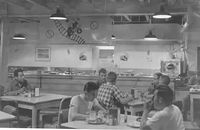 The number of personnel on the tower was limited to about 57 at a time and because some of the specialties were not normally used in the Air Force (like crane operators and boatmen) each position was carefully selected. Shift personnel normally worked 12 hours on, 12 hours off, 7 days a week, with crews that were smaller than landside stations. A normal tour of duty on the Texas Towers was one year actually on board a tower and it took about two years to accumulate that time. The rotation schedule varied over the years but 30 days on the tower and 30 days off the tower was the target. Time ashore was normally considered off-duty to compensate for the heavy tower work schedule. Early in the operational life of Texas Tower 2 personnel were actually assigned to the 762nd Radar Squadron at North Truro Air Force Station on Cape Cod but by 1960 most tower personnel were directly assigned to the 4604th Support Squadron at Otis AFB and a barracks was provided there for them while onshore. 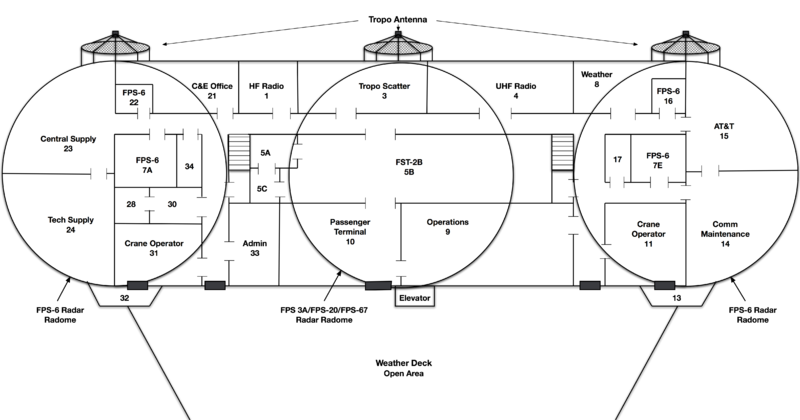
Current StatusAbandoned and sunk in 1963 while being salvaged.
See Also:
Sources:
Links: Visited: 1960-1961
| ||||||||||||||||||||
